Plants can’t survive without water. But too much or too little causes problems that you might mistakenly blame on diseases or insects. More plants have been killed by improper watering than just about anything else. The basic problem is that no two plants have exactly the same water requirements. So you can’t put your irrigation system on auto pilot and give all your plants the optimum amount at once.
The trick for wise watering is that it actually begins with smart planning. Many factors can determine a garden’s water plan—from the type of plants and how they are organized to the time of day they are watered and the style of irrigation installed. And, let us remind you: No two gardens are the same! To help keep your plants happy and the water bill from skyrocketing, here’s everything you need to know about when, how, and how much to water your garden.
What to Consider Before You Plant
If you’re just establishing your garden, now’s your chance to really think about your water solution and get the ideal plan in place. Start with knowing your soil. Soil types differ in how much water they hold and how long they hold it. Sand holds little water and dries out quickly. Clay holds lots of water and dries out slowly. Loam reacts somewhere in between. If necessary, add organic matter to new planting areas to improve soil texture and help hold moisture better.
In planning your plant layout, think in zones. There’s no magic rule of watering that covers all plants. Our advice is to learn as much as you can about the water needs of individual plants, then group together plants based on those needs. For example, put impatiens, cardinal flowers (Lobelia cardinalis), astilbe, and other moisture-loving plants in one spot. Then plant ones that prefer dry soil, such as junipers, sedums, and yuccas elsewhere. Use these guidelines to determine the best ways to water your plants:
| Lawn | * Hose-end sprinklers with built-in timers can work well for a small lawn. * In-ground sprinklers connected to a controller (some newer ones connect to weather stations) will water more precisely. |
| Annuals and Perennials | * Overhead watering may cause flowers to droop or spotting on petals; certain species are more subject to disease if watered from above. * In-ground sprinklers with pop-up risers work in extensive flower beds. Risers should be tall enough that foliage doesn’t block spray. * Choose drip-emitter lines for beds with closely spaced plants. Use individual emitters for widely spaced plants. |
| Ground Covers | * Use in-ground sprinklers; select stationary heads for plantings more than a foot tall and low-precipitation-rate heads for ground covers (including lawns) on a slope. * Drip emitters are suitable for shrubby ground covers. * Drip mini-sprayers work well for mass plantings of small plants. |
| Roses | * Soaker hoses are easy to use on level ground. * Use in-ground sprinklers with flat-head sprayers run early in the day to keep leaves dry to prevent disease. * Drip irrigation with emitter line works well with closely spaced bushes. Or use individual emitters for each bush. |
| Trees and Shrubs | * Use basins around trunks to direct water to the roots and avoid runoff. * Soaker hoses can handle deep-watering of established trees. * Low-volume systems with emitters or microsprinklers are most efficient, especially on sloping ground. |
| Vegetables | * Hand-water in basins and furrows. * Use soaker hoses on flat ground. * Install a low-volume system with emitter line for closely spaced plants, individual emitters for widely spaced vegetables. |
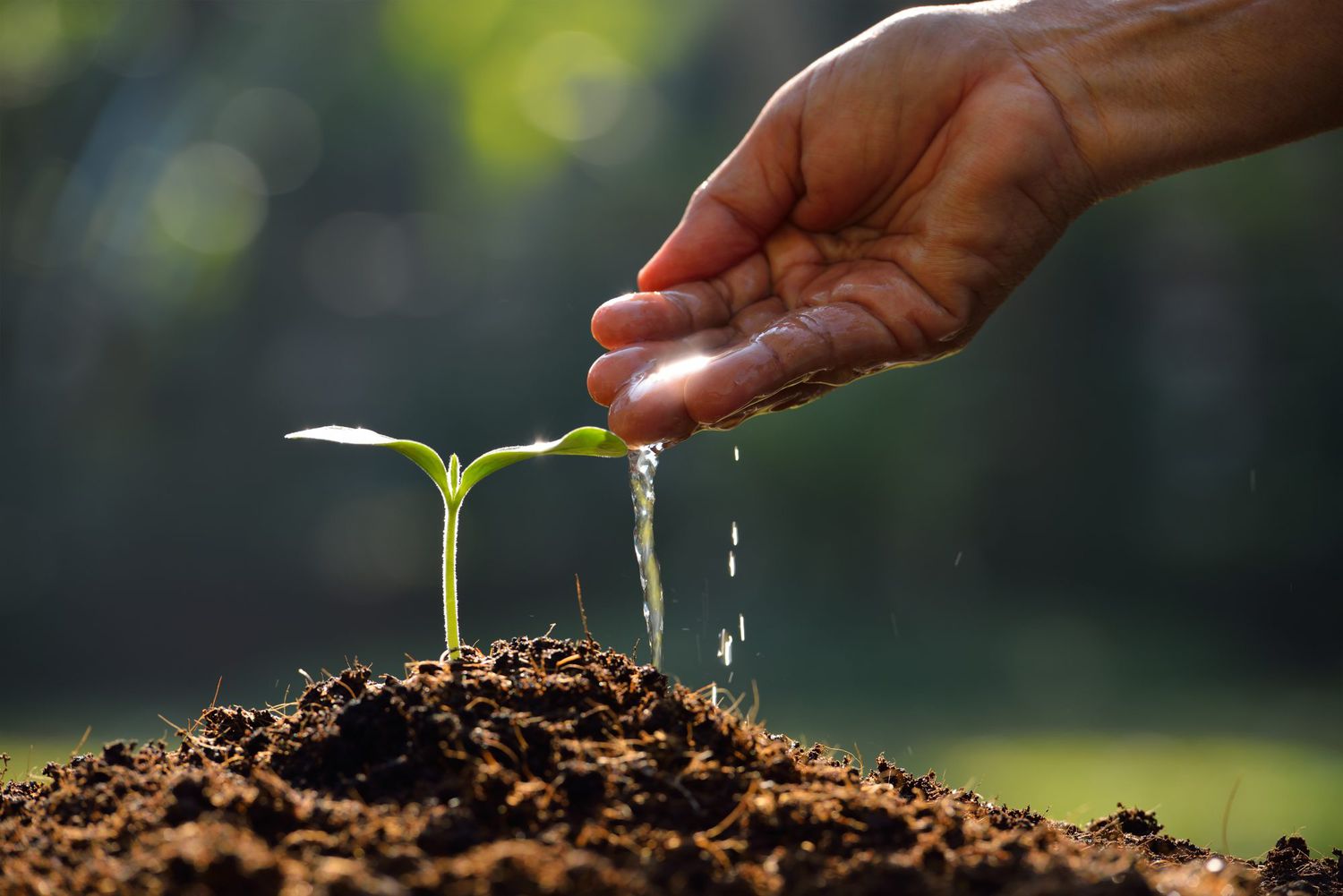
How to Tell if Your Plants Need Water
Like toddlers, plants will let you know when they’re unhappy. Newly planted ones generally need more than those that are established. Do they look stressed? Are they drooping or losing leaves? Feel the soil around them. Don’t water unless the top 2 inches of soil has dried out. How often you’ll need to irrigate depends on many factors, including weather, soil, and plant requirements. When it’s time to water, do so thoroughly. It’s important to remember that infrequent, deep watering is better than frequent, shallow watering because it promotes deeper root growth. Here are some common ways plants tell you they’re not getting the right amount of water:
| Too Little Water | Too Much Water |
| Wilting throughout the day | Wilting in bright sunlight |
| Leaf scorch on the edges of leaves | Yellowing leaves |
| Leaves that curl or drop prematurely | Leaves that drop while green |
| Leaves that lose their bright green color | Sudden collapse of plant |
| Flowers that drop prematurely | Rotting roots |
| Fruit that shrivels and drops before maturing | Malodorous soil |
| A lawn that shows footprints 10 minutes after you’ve walked across it | Edema (blisters that form on leaves) |
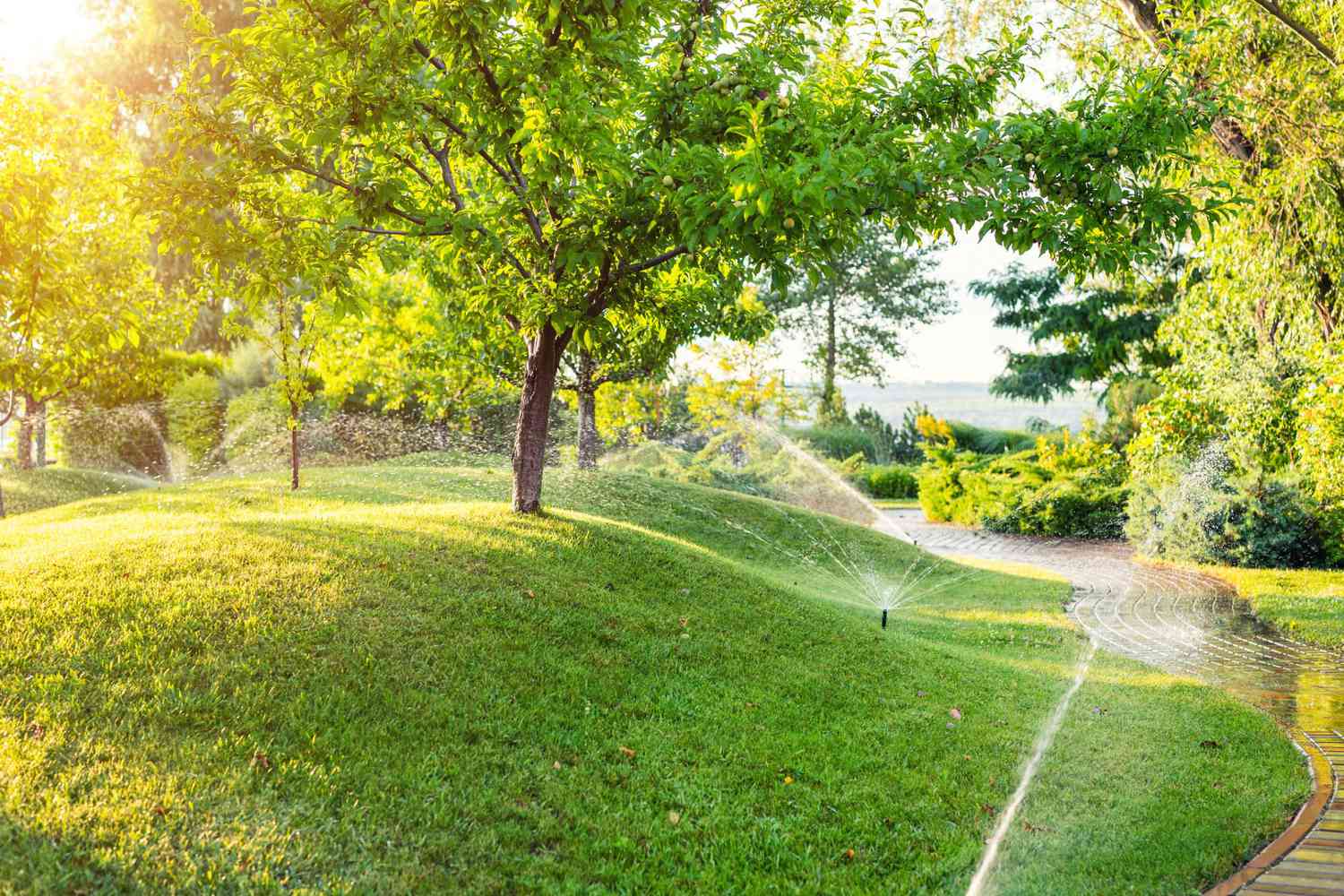
What Time of Day to Water
Start the day off right. If plants need water, early morning is the perfect time to do it. This will carry them through the heat of the day. Late afternoon is not as good because of increased water loss through evaporation. Also, if leaves do not have time to dry, the cooler evening air can encourage fungal growth.
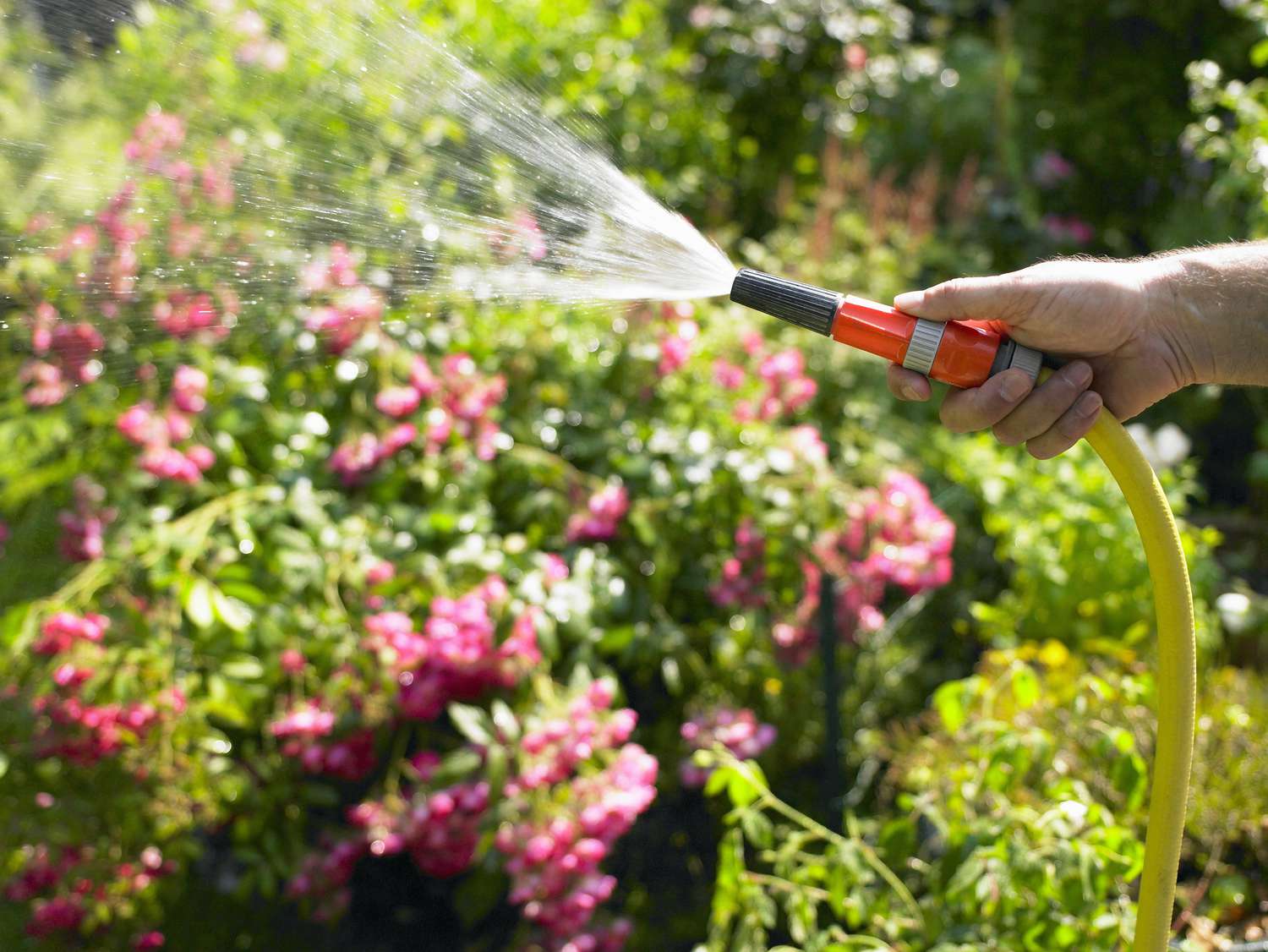
Different Watering Methods & Tools
The equipment appropriate for your garden depends on how often you need to water, the size of your garden, and how much gear you want to buy. Below, we break down the different types of tools for applying water—from simple handheld sprayers to hose-end sprinklers to more complex underground rigid-pipe and drip systems.
Hoses
These come in lengths up to 100 feet and with standard diameters from 3 ⁄8 to 1 inch. A 5 ⁄8-inch size is best for all-around use. Keep in mind that as hose length increases, water pressure decreases, so the longer the hose, the larger diameter you should consider.
Portable Hose-End Sprinklers
These include stationary models that resemble salt shakers or rings; oscillating, rotating, and impulse sprinklers; and «walking» types that slowly roll through the area to be irrigated. When selecting a sprinkler, look for one with a coverage pattern that most closely matches the area to be irrigated (the shape and size of the space the sprinkler covers should be listed on the package).
Soaker Hoses
These long tubes—made of perforated or porous plastic or rubber with hose fittings at one or both ends—deliver water slowly. When you attach a soaker to a regular hose and turn on the system, water seeps or sprinkles from the soaker along its entire length. We suggest watering wide beds by snaking soakers back and forth around the plants, or trees and shrubs by coiling the soaker hose over the outermost edges of the root zone. When covered by a layer of mulch, soaker hoses lose very little water to evaporation. They are ideal for rows of vegetables or long, narrow beds, but they won’t work for an expanse of lawn. They are also good on steep slopes, where sprinkler sprays might lead to runoff and erosion. You’ll probably need to leave soakers on longer than you would sprinklers. To determine timing, check water penetration with a trowel or screwdriver.
In-Ground Sprinkler Systems
These offer some advantages over hose-end options. They free you from moving hoses and can operate even if you’re away from home. Newer sprinklers produce less runoff and overspray and distribute water more evenly. It’s a good idea to hire a professional to plan and install the system, which entails much physical labor. For such a system to work properly, it must be well designed, with as few sprinklers as possible to achieve head-to-head coverage, and sprinkler heads positioned to prevent overspray onto paved areas. After all, you don’t want to water the street. Also set separate spray patterns for lawns and other plants. A heavily mulched planting bed will need much less water than your lawn.
Sprinklers simulate rain, except that sprinkler heads often throw the water horizontally. This means you need to watch out for rain shadows, which are dry areas caused by trees, shrubs, and other obstacles that block the water spray. Sprinklers are the best method for watering turf and large areas of ground covers. Set sprinkler heads at different angles and with generous overlaps to make sure all areas are covered.
Drip Irrigation
Drip or low-volume irrigation delivers water at low pressure and volume (in gallons per hour) to specific areas or individual plants. Water penetration is slow, its depth regulated by the length of time the system is on. The tubing with inline emitters, shown at bottom, encircles a citrus. U-stakes hold the line in place.
As with soaker hoses, drip irrigation systems can be covered with mulch to minimize evaporation or runoff. They are perfect for roses and other plants that have problems with black spot, mildew, and other diseases caused by water on the foliage. They can be used anywhere you have individual plants, from cabbages to oak trees. They also work for containers and even hanging baskets. Components of a drip system include:
- Drip Emitters: These release water directly to the soil and waste virtually no water.
- Mini Sprinklers: Available in many different styles, which vary primarily in output (gallons per hour) or in the watering pattern. Mini-sprayers and mini-sprinklers, which spray water into the air, deliver less water than ordinary sprinklers do.
- Controllers: Technology can help you to water more efficiently. Rain sensors override automatic controllers after significant rainfall. Newer controllers are easy to adjust seasonally, and some can be connected to moisture sensors or weather stations. They can reduce waste and do a better job of watering than most gardeners can.

How to Use Rainwater Wisely
Like pennies from heaven, rainwater is a gift. Don’t let it run off your roof and down the storm drain. Save it for a non-rainy day. Here are some smart ways you can make the rain work for you:
Install a Rain Barrel
All the water that hits your roof and is channeled through the downspouts can be saved to water your plants. Simply cut your downspout to the height of your barrel and divert water into it. For ease of watering, elevate your rain barrel so when the hose is connected to the bottom, gravity helps the water flow from the spout. Place containers nearby to keep them within reach, or plant around your barrel. To keep mosquitos at bay, choose a barrel that is sealed around the downspout. For more water, install barrels at each downspout, connect several rain barrels together, or go for a larger cistern.
Hang a Rain Chain
This simple, time-honored gardening trick guides rain down from the roof into a large pot or planting bed. It can be as basic as a heavy gauge metal chain you pick up from the hardware store or as elaborate as a hand-forged piece of art.
Plant a Rain Garden
A rain garden is a depression in the landscape where runoff can collect. It’s filled with plants, so don’t picture a giant mud hole. Water that collects there will slowly soak back into the landscape over a 24- to 36-hour period. Check with your local nursery for plants best suited for your area that don’t mind being inundated with water for brief periods.
Pick Permeable Hardscaping
Paths and patios that are paved with gravel, spaced flagstones, or porous concrete are the best choices for water-conserving gardens. They allow rainwater to pass through them and into the soil, watering plants and preventing runoff that can clog storm drains and pollute nearby lakes, streams, and coastal areas.
Related Articles
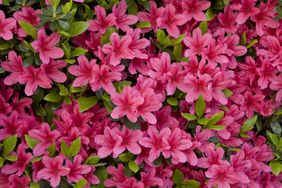
How To Grow And Care For Azaleas
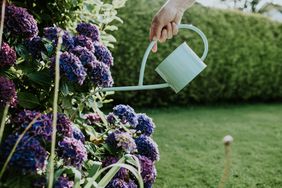
We Hate To Tell You This, But You’re Watering Your Hydrangeas Wrong
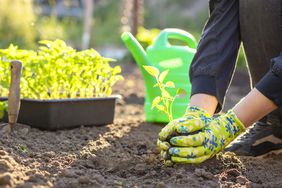
How To Make A Lasagna Garden
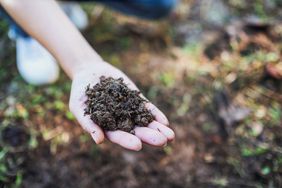
How To Identify Your Soil Type
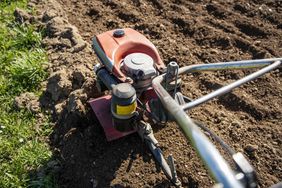
How And When To Till The Soil In Your Garden
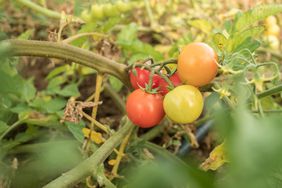
3 Reasons Your Tomato Plant Leaves Are Turning Yellow

Why Are My Tomato Leaves Curling?
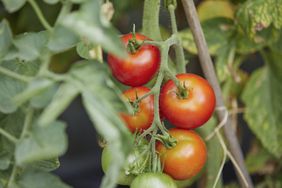
5 Mistakes to Avoid When Growing Tomatoes
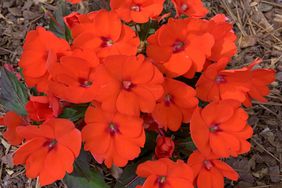
How To Grow And Care For SunPatiens

How Much Mulch Do You Need? Here’s How To Figure It Out
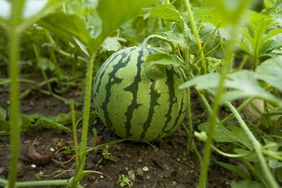
How To Grow And Care For Watermelon

5 Florida Landscaping Rules You Should Never Break
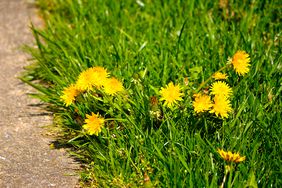
How To Get Rid Of Dandelions
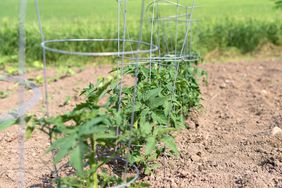
How To Use A Tomato Cage
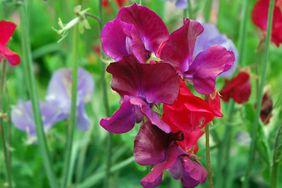
How To Grow And Care For Sweet Pea Flowers

How To Solve Common Crepe Myrtle Problems From Diseases To Pests
Newsletter Sign Up
Newsletter Sign Up
When you visit the site, Dotdash Meredith and its partners may store or retrieve information on your browser, mostly in the form of cookies. Cookies collect information about your preferences and your devices and are used to make the site work as you expect it to, to understand how you interact with the site, and to show advertisements that are targeted to your interests. You can find out more about our use, change your default settings, and withdraw your consent at any time with effect for the future by visiting Cookies Settings, which can also be found in the footer of the site.